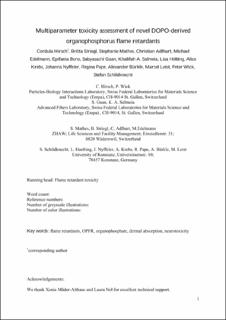Please use this identifier to cite or link to this item:
https://doi.org/10.21256/zhaw-1548Full metadata record
| DC Field | Value | Language |
|---|---|---|
| dc.contributor.author | Hirsch, Cordula | - |
| dc.contributor.author | Striegl, Britta | - |
| dc.contributor.author | Mathes, Stephanie | - |
| dc.contributor.author | Adlhart, Christian | - |
| dc.contributor.author | Edelmann, Michael | - |
| dc.contributor.author | Bono, Epifania | - |
| dc.contributor.author | Gaan, Sabyasachi | - |
| dc.contributor.author | Salmeia, Khalifah A. | - |
| dc.contributor.author | Hölting, Lise | - |
| dc.contributor.author | Krebs, Alice | - |
| dc.contributor.author | Nyffeler, Johanna | - |
| dc.contributor.author | Pape, Regina | - |
| dc.contributor.author | Bürkle, Alexander | - |
| dc.contributor.author | Leist, Marcel | - |
| dc.contributor.author | Wick, Peter | - |
| dc.contributor.author | Schildknecht, Stefan | - |
| dc.date.accessioned | 2018-01-16T15:40:59Z | - |
| dc.date.available | 2018-01-16T15:40:59Z | - |
| dc.date.issued | 2017-03-01 | - |
| dc.identifier.issn | 0340-5761 | de_CH |
| dc.identifier.issn | 1432-0738 | de_CH |
| dc.identifier.uri | https://digitalcollection.zhaw.ch/handle/11475/2064 | - |
| dc.description.abstract | Halogen-free organophosphorus flame retardants are considered as replacements for the phased-out class of polybrominated diphenyl ethers (PBDEs). However, toxicological information on new flame retardants is still limited. Based on their excellent flame retardation potential, we have selected three novel 9,10- dihydro-9-oxa-10-phosphaphenanthrene-10-oxide (DOPO) derivatives and assessed their toxicological profile using a battery of in vitro test systems in order to provide toxicological information before their large-scale production and use. PBDE-99, applied as a reference compound, exhibited distinct neuroselective cytotoxicity at concentrations ≥10 μM. 6-(2-((6-Oxidodibenzo[1,2]oxaphosphinin-6-yl)amino)ethoxydibenzo[1,2]oxaphosphinine-6-oxide) (ETA-DOPO) and 6,6′-(ethane-1,2-diylbis(oxy))bis(dibenzo[1,2]oxaphosphinine-6-oxide) (EG-DOPO) displayed adverse effects at concentrations >10 μM in test systems reflecting the properties of human central and peripheral nervous system neurons, as well as in a set of non-neuronal cell types. DOPO and its derivative 6,6′-(ethane-1,2-diylbis(azanediyl))bis(6H-dibenzo[1,2]oxaphosphine-6-oxide) (EDA-DOPO) were neither neurotoxic, nor did they exhibit an influence on neural crest cell migration, or on the integrity of human skin equivalents.The two compounds furthermore displayed no inflammatory activation potential, nor did they affect algae growth or daphnia viability at concentrations ≤400 μM. Based on the superior flame retardation properties,biophysical features suited for use in polyurethane foams, and low cytotoxicity of EDA-DOPO, our results suggest that it is a candidate for the replacement of currently applied flame retardants. | de_CH |
| dc.language.iso | en | de_CH |
| dc.publisher | Springer | de_CH |
| dc.relation.ispartof | Archives of Toxicology | de_CH |
| dc.rights | Licence according to publishing contract | de_CH |
| dc.subject | Flame retardants | de_CH |
| dc.subject | Organophosphate | de_CH |
| dc.subject | Dermal absorption | de_CH |
| dc.subject | Neurotoxicity | de_CH |
| dc.subject | Polybrominated diphenyls | de_CH |
| dc.subject.ddc | 615: Pharmakologie und Therapeutik | de_CH |
| dc.title | Multiparameter toxicity assessment of novel DOPO-derived organophosphorus flame retardants | de_CH |
| dc.type | Beitrag in wissenschaftlicher Zeitschrift | de_CH |
| dcterms.type | Text | de_CH |
| zhaw.departement | Life Sciences und Facility Management | de_CH |
| zhaw.organisationalunit | Institut für Chemie und Biotechnologie (ICBT) | de_CH |
| zhaw.publisher.place | Berlin | de_CH |
| dc.identifier.doi | 10.21256/zhaw-1548 | - |
| dc.identifier.doi | 10.1007/s00204-016-1680-4 | de_CH |
| zhaw.funding.eu | No | de_CH |
| zhaw.issue | 1 | de_CH |
| zhaw.originated.zhaw | Yes | de_CH |
| zhaw.pages.end | 425 | de_CH |
| zhaw.pages.start | 407 | de_CH |
| zhaw.publication.status | publishedVersion | de_CH |
| zhaw.volume | 91 | de_CH |
| zhaw.publication.review | Peer review (Publikation) | de_CH |
| Appears in collections: | Publikationen Life Sciences und Facility Management | |
Files in This Item:
| File | Description | Size | Format | |
|---|---|---|---|---|
| 2017_Adlhart_Multiparameter_toxicity_assessment_Archives_of_Toxicology.pdf | 193.06 kB | Adobe PDF |  View/Open |
Show simple item record
Hirsch, C., Striegl, B., Mathes, S., Adlhart, C., Edelmann, M., Bono, E., Gaan, S., Salmeia, K. A., Hölting, L., Krebs, A., Nyffeler, J., Pape, R., Bürkle, A., Leist, M., Wick, P., & Schildknecht, S. (2017). Multiparameter toxicity assessment of novel DOPO-derived organophosphorus flame retardants. Archives of Toxicology, 91(1), 407–425. https://doi.org/10.21256/zhaw-1548
Hirsch, C. et al. (2017) ‘Multiparameter toxicity assessment of novel DOPO-derived organophosphorus flame retardants’, Archives of Toxicology, 91(1), pp. 407–425. Available at: https://doi.org/10.21256/zhaw-1548.
C. Hirsch et al., “Multiparameter toxicity assessment of novel DOPO-derived organophosphorus flame retardants,” Archives of Toxicology, vol. 91, no. 1, pp. 407–425, Mar. 2017, doi: 10.21256/zhaw-1548.
HIRSCH, Cordula, Britta STRIEGL, Stephanie MATHES, Christian ADLHART, Michael EDELMANN, Epifania BONO, Sabyasachi GAAN, Khalifah A. SALMEIA, Lise HÖLTING, Alice KREBS, Johanna NYFFELER, Regina PAPE, Alexander BÜRKLE, Marcel LEIST, Peter WICK und Stefan SCHILDKNECHT, 2017. Multiparameter toxicity assessment of novel DOPO-derived organophosphorus flame retardants. Archives of Toxicology. 1 März 2017. Bd. 91, Nr. 1, S. 407–425. DOI 10.21256/zhaw-1548
Hirsch, Cordula, Britta Striegl, Stephanie Mathes, Christian Adlhart, Michael Edelmann, Epifania Bono, Sabyasachi Gaan, et al. 2017. “Multiparameter Toxicity Assessment of Novel DOPO-Derived Organophosphorus Flame Retardants.” Archives of Toxicology 91 (1): 407–25. https://doi.org/10.21256/zhaw-1548.
Hirsch, Cordula, et al. “Multiparameter Toxicity Assessment of Novel DOPO-Derived Organophosphorus Flame Retardants.” Archives of Toxicology, vol. 91, no. 1, Mar. 2017, pp. 407–25, https://doi.org/10.21256/zhaw-1548.
Items in DSpace are protected by copyright, with all rights reserved, unless otherwise indicated.